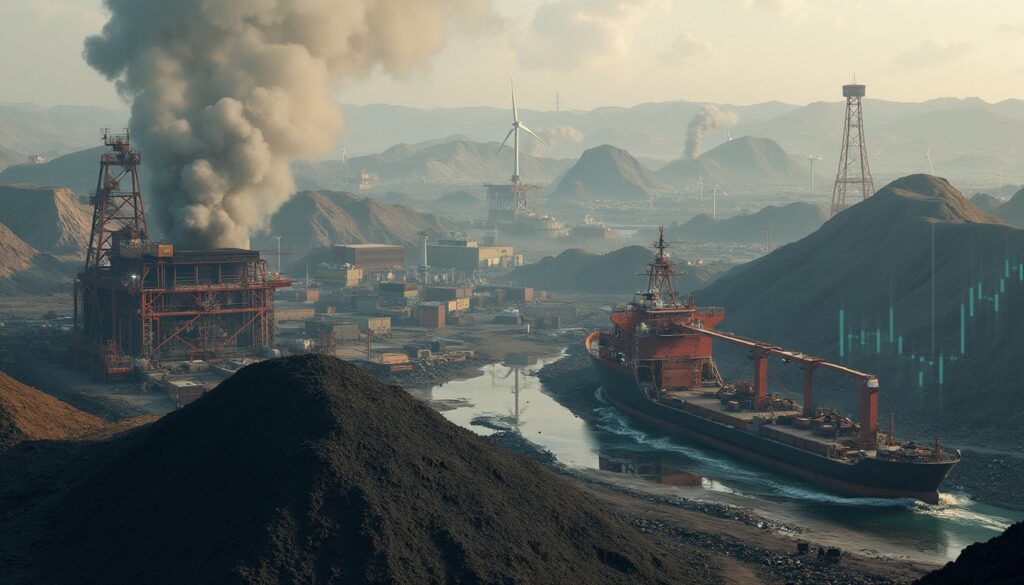The global coal market is seeing unprecedented transformation. Recent trends point to coal's four-year lows global supply squeeze, which has left industry experts cautious amid uncertainty. Investment, demand and supply issues all converge in this evolving environment. This shift has sparked numerous debates among analysts and policymakers.
Which Factors Are Driving Current Market Dynamics?
Technological disruptions, geopolitical tensions and shifting economic paradigms underpin the current state of the industry. Coal's four-year lows global supply squeeze has added complexity to global resource management. Reduced capital investments, volatile demand from emerging economies and stricter environmental regulations are all contributing to the current market climate.
The global network of coal mining and distribution is not isolated. Developments in international logistics are influencing market trends. For instance, companies are navigating global challenges to streamline supply chains amid uncertainty. This evolution has prompted deeper industry analyses to forecast future market directions.
Why Might Coal Prices Rebound?
The market is at the cusp of a transformation. Reduced investments in new coal production may lead to shortages, prompting a price rebound. Investors are closely watching the supply dynamics, realising risks tied to coal's four-year lows global supply squeeze. Forecasts suggest that shortages spurred by diminishing production capacity will eventually stabilise and even raise prices.
Large economies such as India and China retain a significant reliance on coal for industrial growth. Their continued dependency sustains market demand. This resilience persists despite global renewable energy initiatives. Additionally, further insights from iron ore trends help frame the competitive pressures in resources.
Recent analytical insights reveal:
- A decline in new production investments.
- Structural supply constraints emerging in the market.
- Renewed geopolitical interest in securing energy sources.
- The interplay between renewable energy transitions and traditional markets.
According to an analytical report, this confluence of factors is likely to recalibrate the pricing mechanism sooner than anticipated.
How Are the Sectors Adapting?
In reaction to these market shifts, the broader energy sector is realigning its strategies. Traditional fossil fuel investors now face a pivotal choice between continuing their support for coal production or transitioning toward renewable energy. Financial institutions, in particular, are scrutinising coal-related investments more stringently due to the challenges posed by coal's four-year lows global supply squeeze.
Many mining companies are rebalancing portfolios. They are actively pursuing new projects while investing in emerging alternatives. This adjustment marks a significant paradigm shift towards sustainability.
Investors rely on detailed evaluation of market risks. Major banks have tightened their policies on coal financing. Meanwhile, industry forecasts and external news sources provide leadership with helpful context. An industry update has underlined these investment trends in resource sectors.
What Role Does Technology Play in Demand?
The modern energy landscape is heavily influenced by technological innovation. Increasing demand from data centres and high-performance computing is creating new consumption patterns. These digital trends have added layers of complexity to coal consumption forecasts, especially against the backdrop of coal's four-year lows global supply squeeze.
Tech companies are exploring alternative energy sources to address their mounting operational demands. Yet, in many regions, coal remains the most viable option due to its cost efficiency and reliability. As these technological shifts intensify, the industry faces challenges and opportunities in balancing traditional and emergent energy needs.
Increasing computational requirements have led some coal producers to invest in renewable technology. They embrace changes to cater to evolving energy demands. This hybrid approach helps mitigate the risks of supply shortages.
What Are the Broader Economic Implications?
Emerging economies are set to determine the future course of coal markets. Their industrial and infrastructural demands continue to back coal usage, even in an era of decarbonisation. Policymakers are urged to adopt integrated strategies that address both immediate energy shortages and long-term climate ambitions.
Several economic and environmental factors create a complex scenario:
- Investment reductions curbing future production.
- Persistent demand driven by industrial expansion.
- Geopolitical risks influencing trade routes.
- Shifts in finance policies affecting global liquidity.
The recent discussions around coal's four-year lows global supply squeeze emphasise the need for resilience in economic planning. Adaptation remains crucial as markets contend with evolving global pressures.
The Intersection of Policy and Market Trends
Among the most significant factors shaping the market are regulatory shifts and economic stimulus measures. Some countries have introduced policies that both support and constrain coal production. As regulations intensify, the dual pressures of sustainability and market resilience continue to shape industry outcomes.
The influence of governmental initiatives extends beyond domestic markets. For instance, china's economic stimulus has had a notable effect on Australian resources and market dynamics. This illustrates the interconnected nature of global energy policies.
Government policy remains a double-edged sword. While the push for decarbonisation is evident, many nations still depend on coal for strategic reasons. Innovative solutions, such as sustainable technologies and enhanced extraction methods, are gradually gaining traction.
Innovations Driving Industry Change
Technological innovation is poised to reshape coal production and utilisation. New advancements aim to reduce the environmental impact while promoting efficiency. The industry is exploring cleaner extraction processes and waste reduction techniques to meet stricter environmental standards.
Companies are also benchmarking performance against sustainability goals. For example, sustainable steelmaking pilot initiatives highlight the sector’s commitment to cleaner production. Such efforts exhibit the industry's proactive approach to overcoming challenges posed by coal's four-year lows global supply squeeze.
These innovations include:
- Digital monitoring of extraction processes.
- Integration of renewable energy sources.
- Investment in cleaner production technologies.
- Collaboration with research institutions for sustainable practices.
With these measures in place, coal-based operations may find new opportunities to remain viable despite evolving market dynamics.
FAQs: Coal Market Insights
What's driving coal demand in 2025?
Rapid industrial growth in developing regions, expanding energy needs of the technology sector and strategic government initiatives all contribute. These factors are integral to understanding coal's four-year lows global supply squeeze.
How are tech companies influencing coal consumption?
Expanding data centre infrastructure and digital transformation have increased operational energy needs. Even as renewable prospects grow, coal remains crucial for its energy reliability in many cases.
Will coal remain a significant energy source?
Despite the global pivot towards renewable energy, coal continues to serve as a critical component in several economies. Short-term projections underscore its importance in maintaining energy stability and addressing the coal's four-year lows global supply squeeze.
Key Takeaways
- The global coal market faces a unique intersection of decreased investment, supply constraints, and persistent demand.
- Geopolitical and technological factors significantly influence market dynamics.
- Financial institutions have recalibrated investments in response to environmental policy shifts.
- Technological advancements are both a challenge and an opportunity for the industry.
- Government policies continue to shape the delicate balance between sustainability and robust energy supplies.
Coal's four-year lows global supply squeeze has further amplified these challenges. However, the combination of market intelligence and innovative practices may provide the necessary incentives for a rebound in prices.
As the industry navigates the complexities of supply, demand and environmental regulations, stakeholders are urged to remain vigilant. Comprehensive risk assessments and agile strategies will be essential for realising long-term growth amid market volatility.
This dynamic period calls for focused research and proactive adaptations. The synthesis of economic, technological and policy dimensions provides a roadmap for addressing current challenges. Enhanced understanding of these elements is vital for anticipating future trends and mitigating the risks associated with the coal market.
The multifaceted nature of these transformations ensures that strategic investments and policy measures will play a crucial role. By embracing innovation and cross-sector collaboration, the industry can pave the way towards a more stable and sustainable future in a rapidly evolving global energy landscape.
Want to Stay Ahead in Resource Investment?
Unlock real-time insights into significant mineral discoveries with Discovery Alert's AI-powered service, designed to simplify complex market data and help investors—from beginners to seasoned traders—make informed decisions about emerging opportunities in the resource sector. Start your 30-day free trial today and transform how you approach resource investments.




